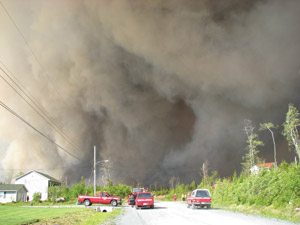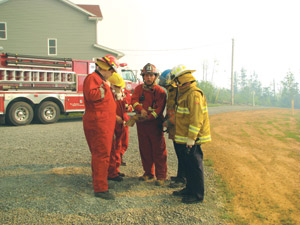
Features
Training
Trainer’s Corner: Assessing variables is crucial to wildland-urban size up
I recently returned from speaking at the 14th Annual FDIC Atlantic, hosted by the Nova Scotia chapter of the International Society of Fire Service Instructors and the Maritime Association of Fire Chiefs.
September 12, 2008
By Ed Brouwer

Firefighters from the Halifax Regional Fire Department were put to the test in June when a massive wildland urban interface fire forced the evacuation of more than 5,000 people in Porters Lake / Lake Echo, N.S.
|
I recently returned from speaking at the 14th Annual FDIC Atlantic, hosted by the Nova Scotia chapter of the International Society of Fire Service Instructors and the Maritime Association of Fire Chiefs. My sincere thanks goes to the men and women who laboured behind the scenes to provide what was, hands down, the best training conference in which I’ve been involved.
I was very pleased to see the interest in wildland urban interface fires, which was the subject of my workshops. My main focus, as is normally the case, was on firefighter safety.
Fighting fire in the interface is not as simple as blending structural and wildland firefighting agencies. We need a better understanding of fire behaviour, due to the complexities of wildfire in the interface. WUI fires offer very unique suppression challenges as well as firefighter safety concerns. One minute of wind direction or speed change and lives can be lost.
Firefighters can’t always contain wildfire in the interface, therefore, staying safe means being diligent about assessing the fire scene, anticipating worst-case scenarios and changing tactics accordingly.
The ability to size up an approaching wildfire that threatens life and property requires quick thinking and vital decision-making skills – skills that can only come from good training and experience.

|
Multiple ignitions, extreme fire behaviour, entire neighbourhoods involved, a mixture of natural and human-made fuels possibly including hazardous materials – add into that mix the emotional charge brought on by the evacuation process and it is easy to become overwhelmed.
As on any fire ground, there needs to be a continual sizing up of the incident. The following article from the California Department of Forestry and Fire Protection proves how quickly things can change in a WUI fire. The only constant is change.
A Few Feet From Safety
On October 29, 2003, a 38-year-old male career firefighter (the victim) was killed and a 48-year-old male career captain was severely injured when fire overran their position. The incident occurred during the protection of a residential structure during a wildland fire operation that eventually consumed more than 280,000 acres.
|
SAFETY ISSUES REVIEW
|
The victim and his crew were part of a task force assigned to protect a number of residential structures located along a ridge on the flank of the fire. The victim’s crew was in the process of preparing to defend the structure when the fire made a slope and wind-driven run through heavy brush directly toward their position. The crew retreated to the residential structure to seek refuge from the oncoming fire. Two of the four crew members were able to get into the structure while the Captain was attempting to assist the victim as the fire reached their position. The victim died near the structure and the Captain, who was seriously burned, had to be assisted into the structure by the other crew members.
The words “a slope and wind-driven run” describe the fire changing gears. Let’s say the fire was moving (rate of spread) at a rate of 10 metres per minute. As it hit the slope, the ROS would double for every 25 degrees of increase in slope. Our fire, with a 50-degree increase, would now have a ROS of 40 metres per minute. Add to this the wind factor. For every 13 kilometres over the original wind speed, the ROS doubles. These firefighters were directly in the path of a rapidly moving fire, driven by wind and supercharged by convection and preheated fuels. If they didn’t have escape routes and safety zones in place before this change in fire behaviour, they certainly didn’t have time to come up with them. We must implement LCES: Lookouts; Communications; Escape Routes; and Safety Zones.
The following news story from Firewise Wildfire News & Notes 2006 address this safety concern as well.
Deaths challenge firefighting strategy
On October 26, 2006, five USFS firefighters were entrapped while engaged in structure protection operations on the Esperanza Fire in Riverside County, California. Three firefighters were killed at the scene, one died en route to the hospital and the fifth died on October 31, 2006. All deaths were the result of burns received at the incident.
The fire produced a rapid rate of spread with extreme fire behavior conditions with wind dominancy. These conditions displayed increased spotting potential with flame lengths of up to 30 metres. A rate of spread of 32 km/h was observed on level terrain. Wind and slope alignment produced a greater rate of spread to 64 km/h that caused temperatures to exceed 660 C ahead of the fire front. A convection column of up to 5486 metres occurred.
At approximately 0620 hours, the branch director meets with E57 at 15400 Gorgonio View Road. At an unknown point in time after the branch director left, E57’s crew deploy a portable pump at the swimming pool to the west of the main residential structure and attach a 1.5-inch hose line, which is laid out to the east side of the residence. A 1.5-inch hose line was attached to a rear discharge of E57.
At 0640 hours, the branch director contacts the operations section chief and the Twin Pines structure group leader to advise them of extreme fire spread upslope toward Twin Pines Ranch Road. He advises them to start evacuations. At 0700 hours, the fire burns up the Twin Pines drainage and crosses Highway 243 south of Twin Pines Ranch Road and is described by the branch director as having very extreme fire behavior with multiple spot fires. Slope and wind alignment in conjunction with multiple spot fires resulted in an area ignition event. These conditions developed a headfire run to the northwest and to the ridgeline. The winds exceeded 80 km/h. The speed and intensity of this fire run overwhelmed the crew of E57. At approximately 0745 hours, a search for the crew of E57 began. At approximately 0800 hours, emergency medical treatment was rendered to the survivors.
We need to put more emphasis on fuel mitigation, pre-planning and cross training before fire season as a way to reduce a fire’s impact and to allow firefighters to know what to expect.
Consider sharing the preceding articles with your members and do some brainstorming.
Divide into groups and drive out to various local WUI locations. Ask each group to do a size-up report and discuss your discoveries back at the hall.
Ed Brouwer is the chief instructor for Canwest Fire in Osoyoos, B.C., and the training officer for West Boundary Highway Rescue. The 19-year veteran of the fire service is also a fire warden with the B.C. Ministry of Forests, a wildland interface fire suppression instructor/evaluator and a fire-service chaplan.E-mail: ed@thefire.ca.
Print this page
Advertisement
- Tools of the Trade: Technical advances boost safety
- Leadership Forum: Fire service leadership beyond lights and sirens